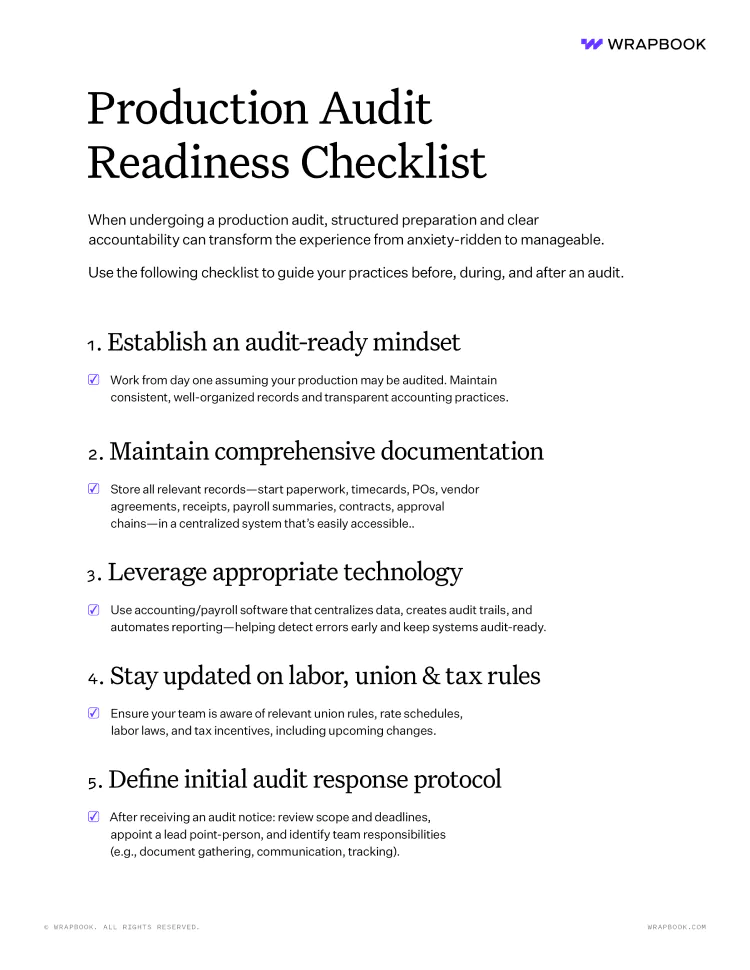

At Wrapbook, we pride ourselves on providing outstanding free resources to producers and their crews, but this post is for informational purposes only as of the date above. The content on our website is not intended to provide and should not be relied on for legal, accounting, or tax advice. You should consult with your own legal, accounting, or tax advisors to determine how this general information may apply to your specific circumstances.
Unions and guilds may audit a production to confirm compliance with their contracts. This can include verifying pension and health contributions, proper payment of overtime and meal penalties, and adherence to safety rules and working conditions.
Knowing what might trigger an audit can help you plan ahead and reduce your risk. Here are a few common issues that can raise concern and result in a production audit for you or your team.
Payroll must align with production reports (PRs), Exhibit Gs, timecards, start paperwork, and contracts. If inconsistencies are found or someone reports a discrepancy—especially around wages or hours worked—it can raise concerns and prompt an audit.
In accounting, documentation is everything. Missing contracts, purchase orders, receipts, or invoices can create doubt and lead to an audit. Every transaction should have a clear paper trail showing what was purchased, why it was necessary, and who approved it. Receipts, receipts, receipts!
When spending exceeds the approved budget or costs are misclassified, it can raise red flags with finance teams, studios, or other stakeholders. Be proactive in communicating budget updates, flagging overages or variances early, and maintaining accurate, consistent coding in your accounting records.
Violating union, guild, or labor laws—such as working conditions, rest breaks, or timely payments—can quickly escalate into an audit. If a worker raises a concern or a union is alerted to a problem, they will likely investigate.
Now that we’ve covered the types of audits and common triggers, let’s talk about how to make your day-to-day practices audit-minded.
The truth is, the best time to prepare for an audit is before one even exists. Work with the assumption that you will be audited, because in many cases you will. By following strong accounting habits from the start, you'll build a foundation that minimizes risk, reduces stress, and helps your team stay focused on the work.
Maintain well-organized and easily accessible records for every financial and labor-related transaction. This includes start paperwork, timecards, purchase orders, vendor agreements, contracts, receipts, payroll summaries, and approval chains.
Whether digital or physical, your documentation system should be consistent and review-ready at all times.
Use accounting and payroll systems that centralize data, automate calculations, and maintain built-in audit trails. These tools can help you catch discrepancies early, reduce manual errors, and generate clean reports on demand. Wherever possible, integrate systems so information flows seamlessly between departments. For instance, Wrapbook syncs with CASHétPay to streamline reconciliations.
Ensure your team is familiar with current labor and union contracts, as well as tax incentive criteria relevant to your production. Know when various union agreements expire or have scheduled rate bumps so you don’t unintentionally process payroll incorrectly.
Now that we’ve covered the types of audits and how to prepare for them, let’s talk about what to do when one officially lands on your desk.
If you’ve just received an audit notice, take a deep breath. You don’t need to panic, but you do need a plan. To help you get organized quickly, we’ll cover how to take initial steps, confirm the scope and deadlines, and set up an audit response process.
Start by reviewing the audit notice in detail. Understand who is requesting the audit, what materials they require, and the timeline for submission. Assign a clear point person to lead the audit response, and clarify roles and responsibilities for everyone involved. Common tasks may include gathering documents, managing communications, and tracking deliverables.
Communicate with the auditor to confirm which materials are needed and when they are due. Clarifying the scope early helps you set a realistic timeline, which can prevent delays, miscommunication, and unnecessary stress.
Staying organized is essential during an audit. Two of the most important steps are creating a centralized location to store all relevant documentation and setting up an internal tracking system to monitor document requests and submissions. These practices help your team work efficiently, avoid duplication, and meet deadlines with less stress.
Production audits can be complex, but many issues arise repeatedly across projects. Being aware of common pitfalls can help you avoid them and keep your audit process smooth and stress-free.
Every financial transaction, contract, and labor record should be properly stored and easily accessible. Missing paperwork slows down audits and raises questions that can lead to deeper scrutiny.
It is essential to accurately classify whether a worker is an employee or a loan-out company and to process payroll accordingly. Supporting documentation such as articles of incorporation, properly completed I-9 forms, and relevant tax documents helps ensure that cast and crew are set up correctly.
Budget overruns or unapproved spending often attract attention during an audit. Keep detailed records of any budget changes, communicate approvals clearly, and ensure all expenses are properly tracked to avoid surprises. Regularly reviewing variance reports and cost reports can help catch issues early and keep spending on track.
Fringe benefits and payroll withholdings can be complicated to track and calculate accurately. Review your production agreements carefully and verify that your payroll provider is set up correctly to ensure compliance and accuracy.
Accurate payroll and start paperwork are essential to demonstrate union compliance.
This includes tracking timecards (rates, meal penalties, turnaround times, and gold periods), documenting pension and health contributions, and verifying correct job classifications. Keep all payroll-related records filed accurately or work alongside your payroll company to prevent costly delays or disputes during an audit.
Effective communication is a cornerstone of every successful audit. By speaking with transparency and confidence to your team, stakeholders, and auditors, you can prevent misunderstandings, build trust, and keep the process running smoothly.
Keep department heads and key stakeholders informed on all audit developments from the moment you receive notice to completion. Maintain clarity around what information is needed, who is responsible for providing it, and when deliverables are due. Regular status updates via brief email summaries or quick stand-up meetings help everyone stay aligned on expectations and timelines.
When auditors reach out, respond promptly and professionally. Acknowledge their requests, confirm your understanding of what they need, and offer realistic deadlines for submissions. If any part of their request is unclear, ask follow-up questions right away to avoid misunderstandings and ensure you deliver exactly what is required.
Keeping your cool under pressure sets the tone for your entire team and helps you work more effectively. Stress and panic can lead to mistakes, missed deadlines, or communication breakdowns.
By maintaining composure, you stay clear‑headed, make better decisions, and model the calm leadership your team needs.
Prioritize tasks based on urgency and impact and delegate responsibilities strategically across your team. Break the audit into manageable phases such as document gathering, internal review, and final reconciliation and track progress at each step.
Focus on keeping the process smooth rather than striving for perfection. Control what you can, and document issues transparently when gaps arise. Treat each audit as a learning opportunity and an instrument of growth for you and your team.
Audits can be long efforts so take care of yourself as well as the project. Schedule regular breaks, set reasonable working hours, and encourage your team to do the same. Maintaining a sustainable pace reduces errors, prevents burnout, and ensures everyone remains clear headed and effective throughout the audit.
Once the audit is complete, take time to review how it went and capture lessons learned. A structured post audit review helps you refine your processes, reinforce best practices, and set your team up for even greater success next time.
Gather everyone involved to assess what went well and identify areas for improvement. Encourage open discussion about roadblocks, unexpected requests, and any communication gaps. Document these insights so you can address them before your next audit.
Use your audit findings to update workflows, templates, and checklists. Share these changes across the company through a quick training session or clear written guidelines so everyone understands the new procedures and why they matter. To keep improvements on track, schedule occasional spot checks or mini audits to catch any new issues early.
Audits can be intense undertakings, so take time to acknowledge the hard work your team put in. Celebrate successes, thank individuals for their contributions, and document key takeaways for the next production. Ending on a positive note leaves everyone feeling accomplished and better prepared for the next one.
Audits can be intimidating, especially if it’s your first time navigating one. But they’re a normal part of working in production, and with strong preparation and clear communication, they don’t have to catch you off guard. By staying organized, keeping thorough records, and understanding audit types and common triggers, you’ll be better equipped to manage stress and handle the process with confidence.
Want to dig deeper? Check out our blogs “Best Practices for Accountants to Maximize Incentives” and “Career Tools for Production Accountants.” And be sure to join the conversation in Room Tone and connect with over 1,000 production accounting professionals!
A production audit is a review or investigation into a production’s financial records, labor documentation, or compliance with applicable regulations. These audits help ensure that funds are spent appropriately, contracts and labor rules are followed, and supporting documentation is complete and accurate.
Whether it’s the end of your show or you’re juggling prep, post, and development all at once, there never seems to be a “good” time for a production audit. But here’s the good news: it doesn’t have to be stressful. With the right support from your team, solid workflows, and reliable software, you can face an audit with clarity and confidence.
Audits can vary widely depending on who initiates them and why. In this article, we’ll walk through the different types of production audits, what might trigger them, and how you can stay prepared.
The level of scrutiny you may encounter for a production audit can depend on the studio, production company, budget size, or sometimes just timing.
Some audits are routine and expected, while others are triggered by specific issues or concerns. Understanding why audits happen and what they aim to uncover is the first step in feeling prepared for whatever comes.
Production audits might come from internal teams, outside partners, or regulatory agencies. Here are some of the most common audits you will likely encounter.
These are conducted by a studio or production company’s internal team and are often done as a preventative measure to identify and fix potential issues early. At larger studios, internal reviews are routine and help ensure that both financial and operational practices meet internal standards.
These audits come from outside stakeholders who have a financial interest in the project. Studios, networks, or bond companies may initiate audits to confirm that money is being spent as agreed and that documentation supports reported costs.
These audits are usually more formal and often come with specific documentation requests and tight deadlines.
Productions applying for state or local tax incentives are commonly subject to verification audits. These audits ensure that all reported costs and labor meet the criteria for eligibility. Clear and thorough documentation is critical. For more information on tax incentives, check out Wrapbook’s Production Incentive Center.